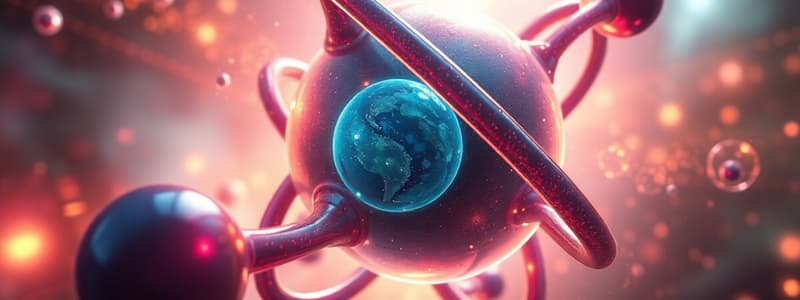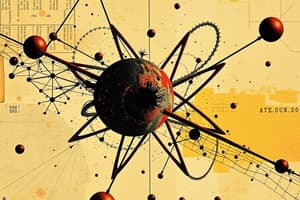Podcast
Questions and Answers
What particles make up nucleons?
What particles make up nucleons?
- Photons
- Electrons
- Quarks (correct)
- Gluons
What charge does a neutron possess?
What charge does a neutron possess?
- +1
- 0.5
- 0 (correct)
- -1
Where are protons and neutrons located in an atom?
Where are protons and neutrons located in an atom?
- Orbitals
- Electron shells
- Nucleus (correct)
- Clouds around the nucleus
What is the charge of an electron?
What is the charge of an electron?
What components make up the atomic mass number?
What components make up the atomic mass number?
How does the atomic number relate to the element?
How does the atomic number relate to the element?
Which of the following statements about nucleons is false?
Which of the following statements about nucleons is false?
If the atomic number of an atom changes, what is the result?
If the atomic number of an atom changes, what is the result?
What does the term 'atom' mean?
What does the term 'atom' mean?
Which subatomic particle is positively charged?
Which subatomic particle is positively charged?
What determines the chemical properties of an element?
What determines the chemical properties of an element?
Which model of the atom proposed by Niels Bohr resembles a solar system?
Which model of the atom proposed by Niels Bohr resembles a solar system?
In Dalton's atomic theory, how were elements classified?
In Dalton's atomic theory, how were elements classified?
What is the atomic number (Z) of an element?
What is the atomic number (Z) of an element?
What type of gases are found in Group VIII of the periodic table?
What type of gases are found in Group VIII of the periodic table?
How are electrons arranged around the nucleus of an atom?
How are electrons arranged around the nucleus of an atom?
Which of the following statements is true about neutrons?
Which of the following statements is true about neutrons?
What are the four classical elements proposed by ancient Greeks?
What are the four classical elements proposed by ancient Greeks?
What is not a fundamental particle of an atom?
What is not a fundamental particle of an atom?
Which scientist first proposed the nuclear model of the atom?
Which scientist first proposed the nuclear model of the atom?
What primarily influences the stability of an atom?
What primarily influences the stability of an atom?
Study Notes
The Meaning of Atom
- "Atom" comes from the Greek words "a" (without) and "tom" (to cut), meaning "indivisible".
- Atoms are the smallest particles of matter that have the properties of an element.
Atomic Structure
- Atoms are composed of protons, neutrons, and electrons.
- Protons and neutrons are located in the nucleus, which is the central part of the atom.
- Electrons revolve around the nucleus in fixed orbits.
Chemical Properties
- The chemical properties of an atom are determined by the number and arrangement of its electrons.
Elements
- An element is a substance made up of only one type of atom.
- There are 118 known elements, of which 92 are natural and 26 are artificial.
Atomic Number
- The atomic number (Z#) represents the number of protons in an atom.
- The atomic number determines the element.
Atomic Mass Number
- The atomic mass number (A#) represents the total number of protons and neutrons in an atom.
Subatomic Particles
- Proton:
- Located in the nucleus
- Positive charge (+1)
- Determines the element
- Determines the atomic number
- Neutron:
- Located in the nucleus
- No charge (neutral)
- Contributes to the atomic mass number along with protons.
- Electron:
- Located in electron shells/cloud surrounding the nucleus
- Negative charge (-1)
- Not included in atomic mass number or atomic number.
Nucleons
- Nucleons include protons and neutrons.
- They are composed of quarks.
- Gluons hold quarks together.
Key Scientists
- John Dalton (1808):
- Classified elements by atomic mass.
- Developed the atomic model, often referred to as the "hook and eye" model.
- Dmitri Mendeleev (late 1800s):
- Arranged elements in order of increasing atomic mass.
- Developed the first periodic table with 8 groups.
- J.J. Thomson (late 1890s):
- Discovered electrons as part of the atom.
- Proposed the "plum pudding model".
- Ernest Rutherford (1911):
- Introduced the nuclear model.
- Proposed a small, dense, positively charged center (nucleus) surrounded by a negative cloud of electrons.
- Niels Bohr (1913):
- Proposed the "solar system" model.
- Proposed electrons revolving around the nucleus in predetermined energy levels.
Studying That Suits You
Use AI to generate personalized quizzes and flashcards to suit your learning preferences.
Related Documents
Description
This quiz explores the concept of atoms, including their structure and properties. It covers key terms such as atomic number, atomic mass number, and the significance of subatomic particles. Test your knowledge on the fundamental building blocks of matter!




